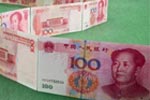Still full steam ahead for China
Updated: 2011-08-20 10:33
By John Ross (China Daily)
|
|||||||||||
The recently published European Union (EU) GDP figures, following those for the United States and Japan, completes the picture of slow growth in developed economies.
Slow growth in the advanced economies is already causing a fall in commodity prices - by Aug 16, the Dow Jones-UBS spot commodity index had dropped by 8.8 percent since its peak at the end of April. This will help China's fight against inflation. But recession in the developed economies would hurt China's exports and increase pressure on the US for a new round of quantitative easing, with destabilizing financial consequences for the world.
But the most decisive trend is not whether the developed economies face a double dip. The key fact, which is already clear, is that even without another recession, growth in the major developed economies is very slow. By mid-2011, that is, more than three years after the high point of the previous business cycle, no region in the developed world had recovered its peak level of GDP. America's GDP is 0.4 percent below its peak in the fourth quarter of 2007. The EU's and Japan's GDP are 1.8 and 6.0 percent below their peaks in the first quarter of 2008. Overall, this represents more than three years of net negative growth in the developed economies.
In comparison, China's economy has grown by more than 30 percent in the last three years. If the growth rate in the rest of the year continues to be as high as it has been until now, the expansion of China's economy between 2007 and 2011 would be 44.5 percent. And, assuming there is no recession in the US and the EU, America's GDP will have expanded by 0.8 percent and the EU's will have contracted by 0.4 percent in the same period.
The figures projected above could change depending on the developments in the second half of this year. But the relative order of magnitude is clear.
All economies continually face problems, though. The most serious one for China now is inflation, followed by the need to control the buildup of local government and other debts. But given China's GDP growth of 40-plus percent in four years, its problems are far less serious than those of the US and the EU.
This should settle the debate among non-Chinese economists on whether China, or the US and EU would emerge the most successful from the global financial crisis. Some non-Chinese economists rightly predicted that China would grow rapidly despite facing some problems, which would be overcome by economic fundamentals, and it would have a "soft landing". Jim O'Neill, former chief economist of Goldman Sachs, who coined the term BRIC, is probably the best known among them.
But others predicted China's economy would perform badly and the US would recover from the financial crisis faster than China. The most extreme among them, such as US hedge fund manager Jim Chanos, feared an economic catastrophe in China. But it is clear that China has come out of the financial crisis almost unscathed, while the US has hardly registered any growth.
The impact of the slow growth of the developed economies on China is that it will have to rely even more on a combination of higher domestic demand and growth of other developing economies. This should not be a difficult task, because seven of the 10 fastest growing economies last year (in terms of dollars) were developing ones - China, Brazil, India, Russia, South Korea, Indonesia and Mexico. The growth in the developed economies in 2010 was $1.6 trillion, whereas in the (World Bank classified) middle-income economies such as China, Brazil, India and Mexico it was $3.3 trillion.
This is not a short-term trend. If we take a five-year period starting before the financial crisis, the average annual growth in developed economies was $1.4 trillion, while in middle-income economies it was $2.0 trillion. Not only in percentage, but also in absolute dollar terms the growth in developing economies is greater than in the developed ones. The trend is of great advantage to China.
Chinese companies face tough competition in advanced markets, where they are up against globally famous brands. But in the developing economies, Chinese companies such as Haier and Huawei are building up strong positions. Their fast expansion in the developing economies, in turn, brings in rapidly increasing revenue that they can plough back into research and development to bolster their challenge in the developed markets.
Mao Zedong once said that in the struggle in China "the countryside will surround the cities". The global economic situation today could be described in similar terms. Slow growth in the advanced economies and rapid growth in the developing ones have created a situation in which Chinese companies are building up strong positions in the "countryside" of the global economy, from where they will be able to challenge its "cities".
The author is a visiting professor at Antai College of Economics and Management, Shanghai Jiao Tong University.














